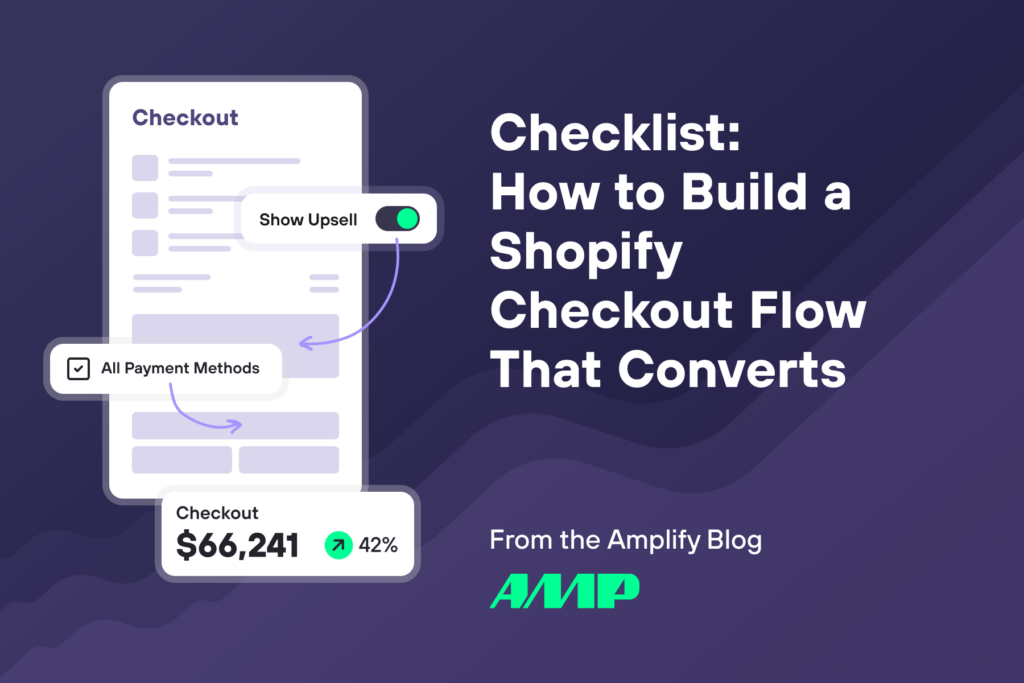Apr 25, 2024
Checklist: How to Build a Shopify Checkout Flow That Converts.
Your online store has been carefully crafted. Your store is an experience for visitors to view your products and lead them to a completed purchase. But, just like a supermarket with a slow checkout lane, an imperfect checkout flow can stop even the most eager shopper. In this article, we provide a checklist that will help guide you to build a seamless Shopify checkout flow, converting browsers into buyers!
What is a Checkout Page?
A checkout page is the last step for a conversion of potential customer to consumer. It’s the final hurdle someone faces before completing their purchase. They will need to review their chosen items, fill in the fields to confirm shipping and billing details, and then finalize payment. The best way to create a successful checkout page is for it to be streamlined, transparent and cultivate trust , making the buying process smooth and secure.

According to a recent study, Shopify Checkout flow converts up to 15% better on average than Salesforce, Magento, and BigCommerce. Backed by Shopify’s vast identity network, unparalleled scale, consumer trust, and rapid pace of innovation, Shopify checkout stands as the best in the world.
Why is it Important to Optimize your Checkout Page?
It is important to optimize your checkout page as it is the last section of processing and a critical point of your customer relationship. A customer needs to feel comfortable to give their address, credit card details and information to receive your product. It is the last step before receiving the product, and it needs to be the most streamlined process to prevent any cart abandonment.
According to studies, an average of 70% of carts are abandonment due to:
- Unexpected fees
- Forced account creation
- Lack of payment options
- Complicated checkout processes
To balance these issues, we need to optimize the checkout page, boosting conversion rates and overall profits.
6 Tips for Shopify Checkout Flow Page Optimizations
This checklist will guide you through building a checkout flow that converts, maximizing your conversion rate and boosting your bottom line.
1. Streamline the Process
Keep the checkout process as simple as possible. Limit the number of steps involved, ideally to a one-page checkout. Offer a guest checkout to new customers, as not all clientele want to create an account on their first purchase. Customers can also utilize autofill features, reducing manual entry for returning customers. Include a progress indicator to show customers how far through the checkout process they are, which can reduce anxiety and encourage completion.
2. Build Trust and Transparency
The best way to build trust and transparency is through communication. Display all costs upfront, including shipping, taxes and any hidden fees as well as security badges and logos from payment processors. Additionally, make sure your return policy is easily accessible and understandable.
3. Encourage Upsells and Cross-sells
Consider offering strategically placed upsells throughout the checkout process to boost your average order value. Inspire your customers to add related products at the Checkout page by highlighting complementary products, loyalty programs or offer free shipping incentives when they reach a certain threshold to significantly enhance the user experience.
Using Upsell by AMP, a customization feature on Shopify Plus, you can increase your cart value using upsell offers at the Checkout Page. This app further enriches the checkout experience, providing owners with multiple ways to custom design their checkout process.
4. Multiple Payment Methods
Offer a variety of popular payment options. The easier it is for them to find their preferred method, the quicker they’ll be to proceed with their order. Consider adding a field for discount or promo codes and easy gift card redemption.
5. Enhance the User Experience
Provide a clear and concise order summary throughout the checkout process. This allows customers to review their selections and make any necessary changes. Display estimated and delivery times upfront to allow the customers to plan accordingly. In addition, offer live chat support during the checkout process to clear any questions or concerns from the customer.
6. Reassurance and Confirmation
Send to the customer a clear confirmation email after a successful purchase. This email should include order details, estimated delivery date, and a link to track the shipment. Include a thank you message in the confirmation email, expressing appreciation for the customer’s business, as well as a survey so that you can receive more data and analytics for their future purchases.
Shopify Checkout Page Customizations Everyone Can Do
How to Edit the Shopify Checkout Page (Non-Plus Users)
If you are not a Shopify Plus customer, you have the more limited checkout customization available. You can make changes to elements like your logo, length, text, and limited design options.
How to Edit The Shopify Checkout Page (Shopify Plus Users)
If you do have a Shopify Plus account, you have the full capabilities to customize the Checkout page. To customize your checkout page, you will need to add apps published on the Shopify App Store. You can install these apps through Shopify Plus to create your bespoke checkout experience.
For example, the Upsell by AMP shopify app caters especially to Shopify stores, is fully customizable and optimized for the reliability you need to provide to your customers. Moreover, it covers all upselling needs, instant 1 click orders, adds reviews, and social proof.
Remember, checkout flow optimization is an ongoing process. Regularly evaluate your results and make adjustments to improve the conversion rate. By following this checklist and continuously refining your checkout flow, you can create a seamless and user-friendly experience that converts website visitors into loyal customers.
Boost sales and AOV with upsells, customized offers and surveys for a seamless shopping experience on your Shopify store.
Start today,
for free
Start a free trial of any of AMP’s tools today.

